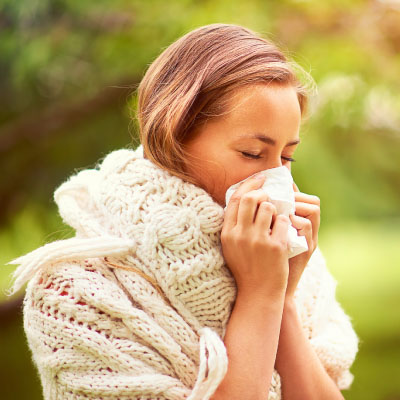
ABCs of Spring Allergies
Spring brings sunshine, flowers and buzzing bees. But for those with seasonal allergies, spring can also mean sneezing, nasal congestion, itching and watery eyes. Often caused by pollen, grass or mold, symptoms can begin as early as February and last until the beginning of summer. Fortunately, there are some simple steps to help reduce and alleviate the symptoms of seasonal allergies and get back to enjoying spring.
The first step to prevent allergy symptoms is to determine the cause. A visit to the allergist or allergy specialist can help determine the trigger of your allergies. The allergist may perform a series of tests, with skin tests being the most commonly administered. This requires placing a small sample of the allergen on the skin and waiting for a reaction. Formation of a small red bump where the allergen was placed usually indicates an allergic reaction. However, the allergist may perform additional tests to be certain.
Complete avoidance of the allergy trigger may be a challenge, but there are a few easy and inexpensive ways to decrease your contact with allergens:
• Use an air conditioner in the home and car instead of using a fan or opening the windows.
• Use a dryer or dry clothes indoors to prevent pollen from getting onto clothes.
• Try to stay indoors on windy days.
• Keep pets clean to prevent pollen from accumulating in their fur.
If symptoms still persist after avoiding allergy triggers and quick relief of allergy symptoms is needed, a few over-the-counter medications are available. Though these are not permanent solutions, they can help relieve symptoms until a doctor is consulted about the long-term management of allergies.
Antihistamines
Oral antihistamines can help relieve the symptoms associated with seasonal allergies: sneezing, itchy eyes, and a runny nose. Antihistamines, such as fexofenadine (Allegra®) or loratidine (Claritin®), are available over the counter and cause less drowsiness than other antihistamines such as diphenhydramine (Benadryl®) or chlorpheniramine (Chlor-Trimeton®).
Nasal Preparations
If nasal congestion and a runny nose are your primary symptoms, intranasal allergy medications may help relieve these symptoms.
Nasal corticosteroids, such as fluticasone (Flonase®) and triamcinolone (Nasacort®), are available over the counter and may be combined with oral antihistamines. Cromolyn (NasalCrom®), another over-the-counter nasal spray, can prevent allergy symptoms by blocking the release of histamine.
Decongestants
Many oral and nasal decongestants are available over the counter to aid in relieving nasal and sinus congestion. Pseudoephedrine (Sudafed®) and phenylephrine are common oral decongestants while oxymetazoline (Afrin®) is available as a nasal spray. It is advised not to use nasal spray decongestants for more than three days as it can make symptoms worse. Combination tablets of a decongestant and antihistamine, such as pseudoephedrine and fexofenadine (Allegra-D®) and pseudoephedrine and loratadine (Claritin-D®), are also available over the counter.
Eye Drops
For symptoms of itchy, burning and watery eyes, eye drops containing antihistamines and/or decongestants may be used. Some over-the-counter eye drops include ketotifen (Zaditor®), naphazoline (Clear Eyes®), naphazoline and pheniramine combination (Visine-A®).
Allergies can be uncomfortable and determining the cause can be difficult. However, there are simple lifestyle changes and treatments that can help prevent and alleviate the unpleasant symptoms. If you have other health conditions and are considering taking medications for allergies, discuss it with your doctor or pharmacist to prevent possible drug interactions and side effects. If symptoms continue or worsen, a doctor should be consulted to explore other treatment options.
